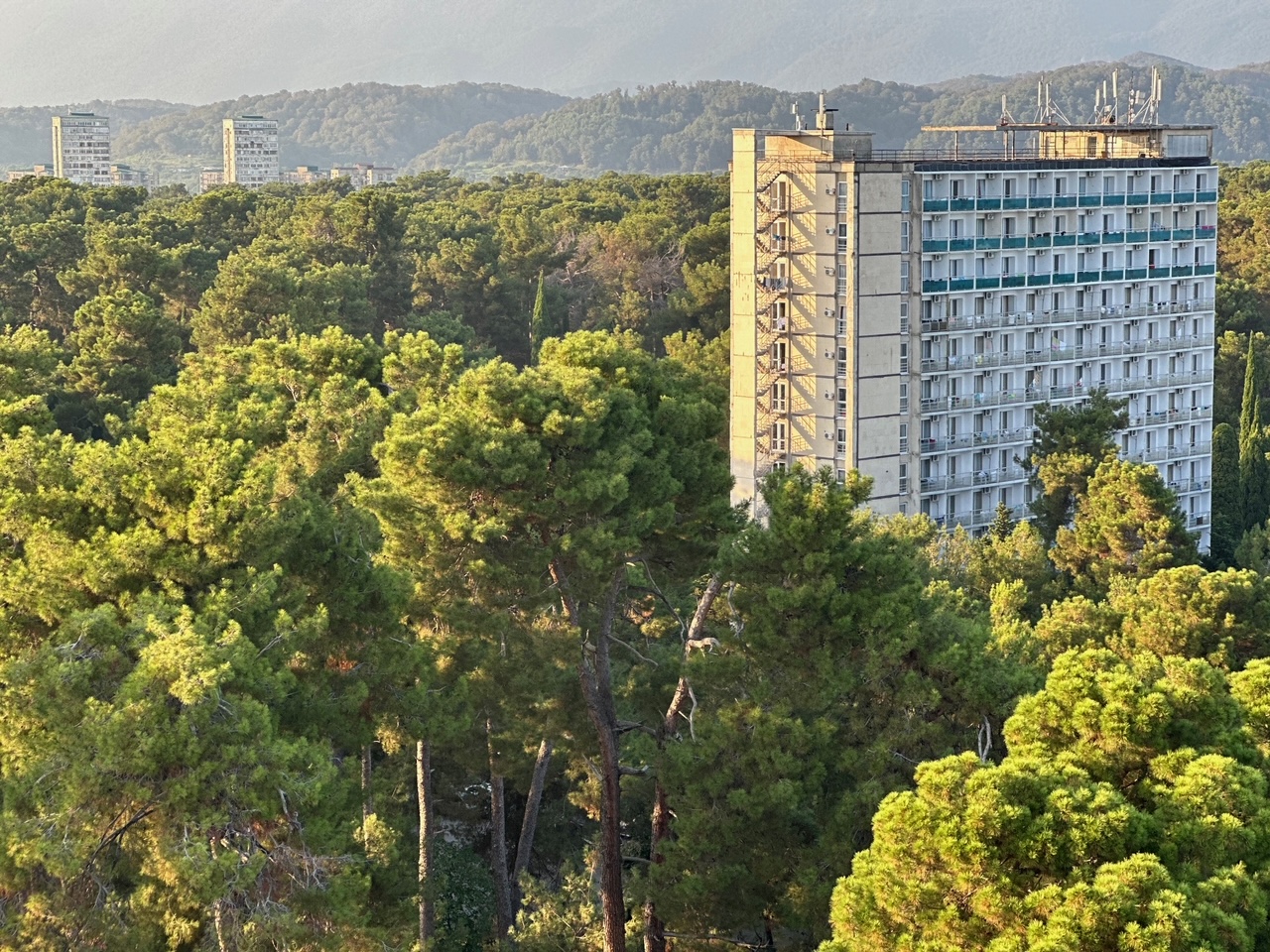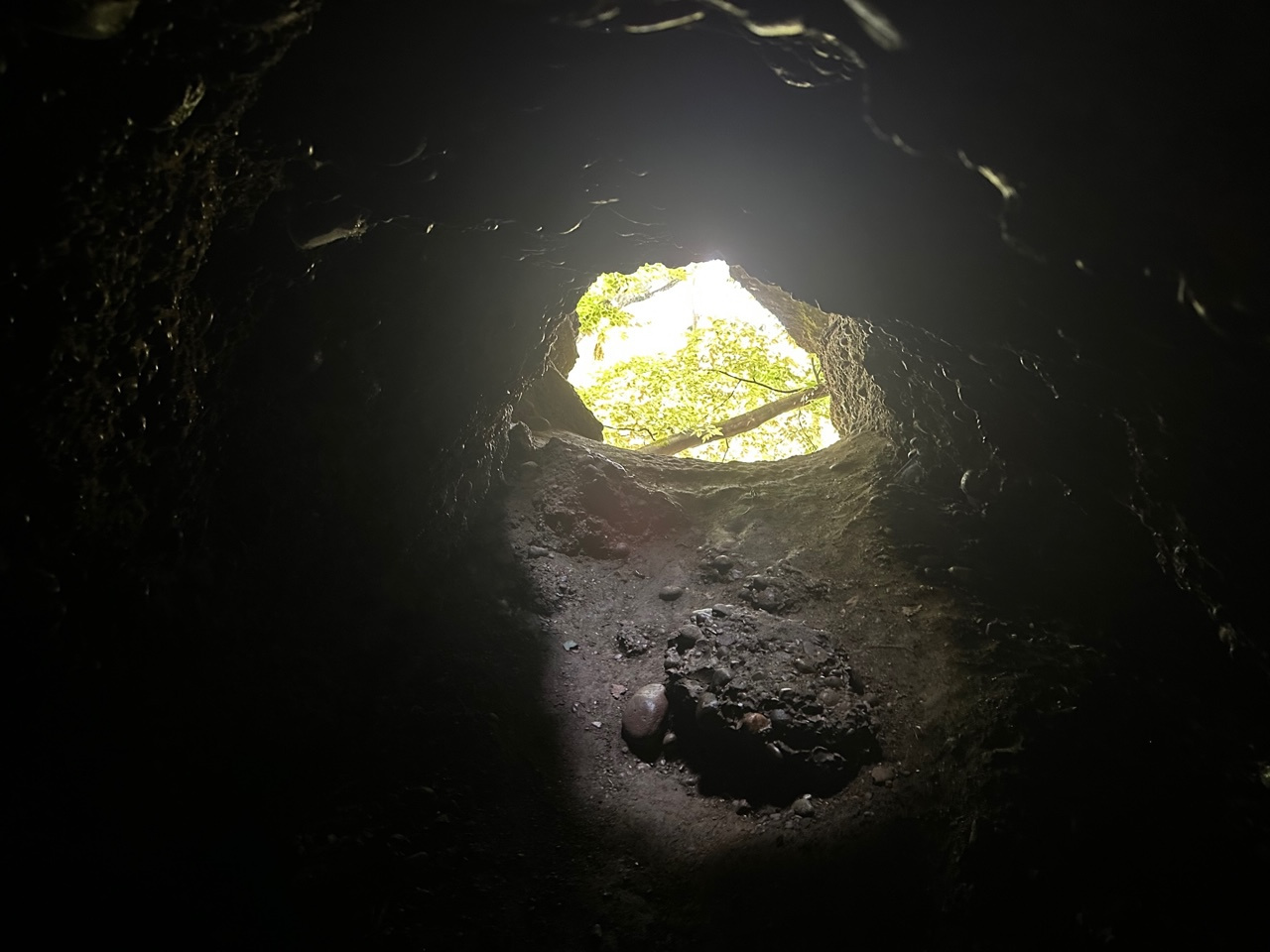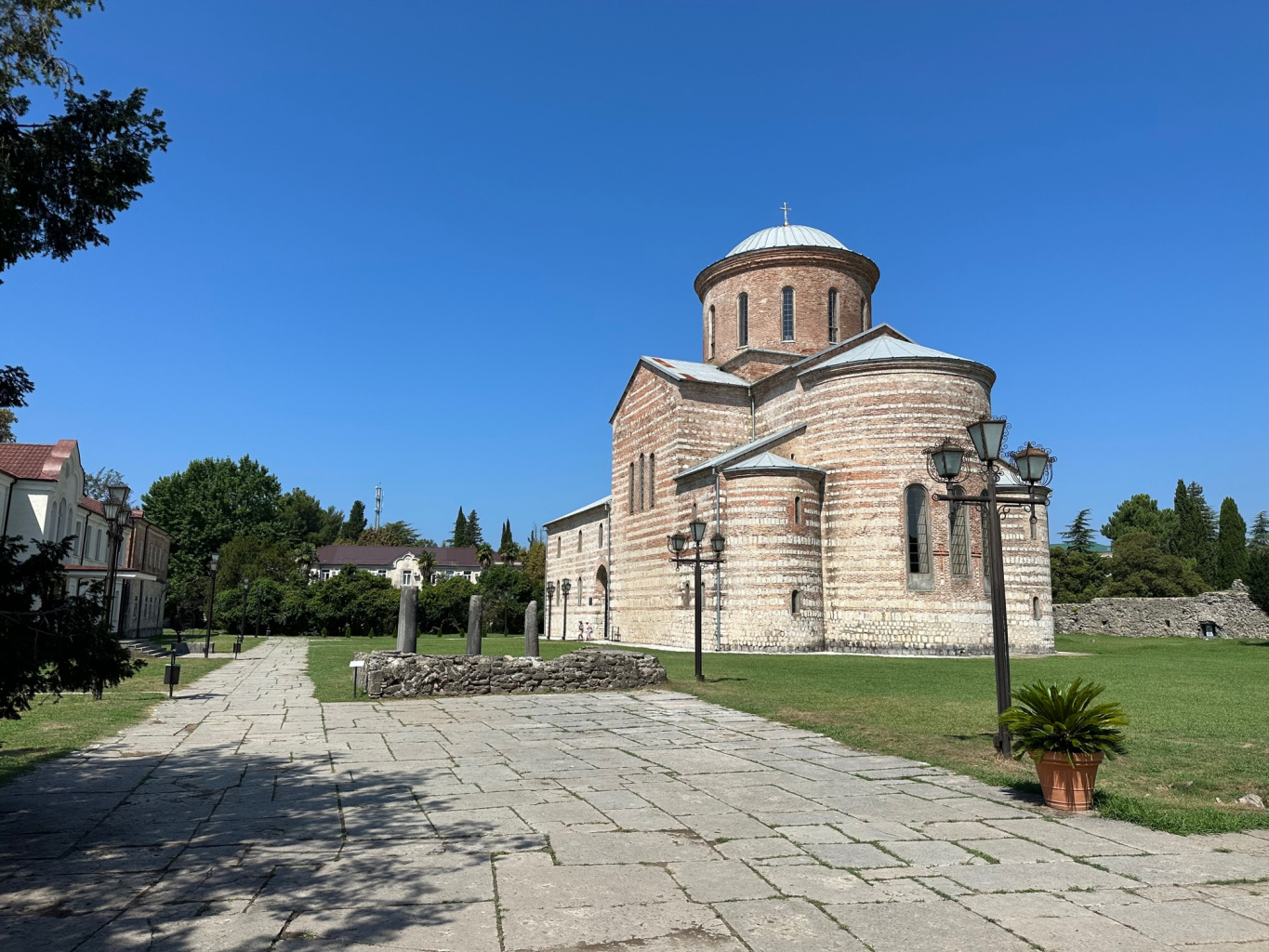For 4 years in a row, Russia and Abkhazia have been connected by the Sochi tourist train in summer. The train running along the route Tuapse-Gagra is made in the USSR-time style and allows the passengers to avoid many hours of traffic jams at the border, and also to “feel” what the dream of the Soviet people was. Indeed, time stood still in Abkhazia and it all looks like it was frozen in time. Our correspondent found out where the leaders of the Soviet Union spent their vacations, how to touch high culture, swim without a noisy crowd swimming around and “see the light at the end of the tunnel”. She visited Pitsunda. A voucher for the excursion to the popular Abkhazia’s resort town can be purchased while traveling by the Sochi tourist train.

From the Greeks to Khrushchev
“Pitio!” exclaimed the ancient Greeks who arrived at the Black Sea coast of present-day Abkhazia in the 2nd century B.C. when they saw pine trees. A lot of oher peoples who lived in this beautiful place have changed this word during the years and it became the modern name of the town of Pitsunda. This was not by chance because the famous pine trees grow at the coast. Their needles are several times longer than those of other conifer trees, which means that six times more phytoncides are released that are good for the prevention of pulmonary diseases and even tuberculosis. And the most transparent sea on the entire coast is in Pitsunda. The bottom is visible even at the depth of 28-30 meters. That is why Pitsunda, with its amazing pine trees and the purest sea water, was chosen as a vacation place by Nikita Khrushchev, the First Secretary of the Central Committee of the CPSU. A dacha (vacation house) was built there for the leader of the USSR.
“Today, Khrushchev’s dacha is a health center for those who work at the Federal Security Service of Russia, and President Vladimir Putin also stayed there during his visit to Abkhazia. It is impossible to get to this dacha, but one can see on the screen how the Soviet leaders spent their vacations. The movie “Grey Wolves” was filmed at Khrushchev’s dacha in Pitsunda,” says our guide Marina Bankovskaya.
By the way, the dacha in Pitsunda turned out to be not a very happy place for Nikita Khrushchev, he was removed from his office when he was in Pitsunda on vacations. The General Secretary did not have time to return to Moscow. Perhaps, that is why Leonid Brezhnev, the next leader of the USSR, preferred to go to the Crimea on vacations. And in Pitsunda, a resort for workers was set up on his order - seven fifteen-storied buildings were constructed in a pine grove. Unfortunately, it was very difficult for ordinary Soviet citizens to get into the Pitsunda’s resorts. Mostly tourists from the countries of the socialist camp - Bulgaria, the Czech Republic, German Democratic Republic and other countries - enjoyed the vacations in Pitsunda.
30 years after the collapse of the Soviet Union, almost nothing has changed in the high-rise buildings of the resort’s hotels. The same sea breeze with the smell of pine needles blows along the flights of stairs, the sun shines bright on the terrace of the restaurants located on the roofs, the famous “herringbone” parquet flooring. And all this is filled with the happiness of a Soviet person who came to the warm seaside. And one can see everything that was preserved here. A ruined summer cinema and a dance floor, tiles falling apart on the embankment, shabby walls of buildings. Nevertheless, with hotel room prices from 2,500 to 5,000 rubles per day, the Pitsunda resort complex is 100 percent booked this summer season, up to November 15 when the resort complex closes for the winter season. It is understandable as the sea in Pitsunda is the most transparent on the entire Black Sea coast.
Uninhabited island with a ‘gray’ forest
Abkhazian guides are, of course, gods of marketing. “Robinson’s Island” or a “piece of a paradise lost on Earth” - this is how they describe Shlypra Island. In fact, it is not an island but a peninsula, or rather, a wild beach, reliably “fenced off” by beautiful mountains from the mainland, so the people can come to the peninsula only by sea. And while there is a lot of talk in Sochi about the resumption of maritime communication and designing ports and ships, the Abkhazian captains repair the Soviet-made “motorboats”, install metal seats on them and cheerfully sail over the sea. A trip to Shlypra from Pitsunda takes about 20 minutes and costs 800 rubles for four persons.

“Shlypra is a “gray forest” in Abkhazian language. The peninsula is part of the Pitsunda-Myussersky Reserve. Oak trees, beeches, and hornbeams grow on Shlypra. Many trees have gray trunks, and when the first frost covers them in late autumn, they look silver,” the guides say.
Those who want to feel like Robinsons on Shlypra and meet their Man Friday will find a bright turquoise sea with light, sand-like pebbles, umbrellas made of palm leaves, all framed by dense green oleanders. By the way, one cannot say that the “island” is uninhabited. Firstly, during the summer season, 500 tourists from Gagra or Mussera arrive here every day. And secondly, those who think that the Pitsunda beaches are already very crowded come here with tents. There are really fewer guests on Shlypra. And “tent campers” say it’s quiet and safe here. Vacationers can leave their things, go hiking for a few days, come back and everything is in place. Well, the mobile phones can be charged at a small cafe. Robinson could only dream of such services.
“The season on Shlypra lasts until mid-October. When it starts raining and during storms, the “island” is blocked, no one can leave it,” the guide added.
But not only the sea and hot khachapuri (Georgian cheese-pies) are the tourists’ pleasures on Shlypra. What about seeing the “light at the end of the tunnel”? Once, Emperor Nicholas II of Russia wanted to connect Russia with Georgia by a railway built along the Black Sea coast. The builders started to cut a tunnel through the rocks on Shlypra. The emperor’s dreams did not come true, but a thrilling tourist attraction appeared. The guides provide safety during the descent into the man-made cave saying “We will lend everyone a helping hand.”

Playing the organ to the sound of the waves
Tourists in Pitsunda can enjoy not only for the sea, pine trees, islands, but a local culture as well. The famous cathedral is located here. Pitsunda is one of the important centers of Christianity on the Black Sea coast of the Caucasus.

“Rus’ (Russia) was baptized in 988, and Christianity came to Abkhazia in the 4th century. At that time, this land was the outskirts of the Roman Empire. A Roman cohort was stationed in Pitsunda. Here, the Roman emperor Diocletian, a pagan, exiled 40 Christian soldiers to hard labor, all of them were Syrians. These people united and created the first Christian community on the Black Sea coast. In 313, the Edict of Milan was adopted allowing the spread of Christianity on the outskirts of the Roman Empire. There is evidence that Bishop of Pitsunda Stratophil took part in the First Ecumenical Council that took place in 325 in Nicaea,” says Marina Bankovskaya, our guide.
In the 10th century, when the lands of Abkhazia were under Byzantium, a large Christian cathedral was built on the foundations of the Roman temple in Pitsunda - 31 meters high with 1.5-meter-thick walls. And the foundation of a grandiose structure was just one meter high.
“When the Ottoman Turks “came” to Abkhazia, the cathedral fell into disrepair. Over the years, the winds have brought soil and seeds to its roof, and fruit trees have grown on it. The restoration of the cathedral began only in 1810 when Abkhazia joined the Russian Empire. It should be mentioned that since the construction of the cathedral in the 10th century, it has never been repaired, only windows and roofing have been replaced. The walls of the cathedra with the stones alternate with red bricks fastened with lime mortar are an excellent example of the Byzantine masonry,” the guide notes.

Services at the Pitsunda Cathedral continued until 1931. In the Soviet times, the temple housed a club, a warehouse or a cinema. In the 1960s, it was a local lore museum. And later, given the abundance of foreign tourists in the resort town of Pitsunda, an organ was installed in the cathedral. It was made in the German city of Potsdam and within two years, a 200-ton organ was transported to the Soviet resort town by sea. The first concert of organ music at the Pitsunda Cathedral was held in 1975. Since then, the organ music concerts have become traditional. In summer, people can listen to the organ music in Pitsunda every day at 5 p.m. An entrance ticket to such a concert costs 1,300 rubles per adult. The repertoire of the Abkhaz organ players includes not only the classical music by Bach, Handel or Liszt, but also the melodies from the film “Seventeen Moments of the Spring” and even rock, such as the music of the German rock band Scorpions.


